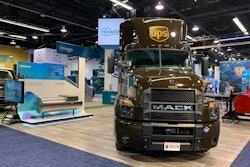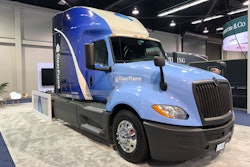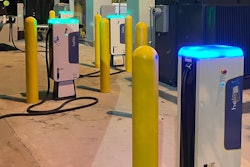Freight’s path to zero emissions requires all modes of transportation to reduce their carbon intensity and particulate emissions. Can trains and trucks learn from each other to help accelerate the process?
I recently had the opportunity to listen in on the Rail Electrification Council (REC) of the National Electrical Manufacturers Association (NEMA) Spring 2023 meeting. Attendees included experts from a variety of North American railroads, rail equipment manufacturers and rail industry groups.
The REC discussions greatly paralleled those NACFE has had on zero-emission trucks. Both rail and trucking are facing extraordinarily rapid innovations in powertrain technologies, embracing a variety of energy types, with a growing pressure from both customers and regulators to move toward zero- emission transport.
Rail and trucks are simultaneously both competitors and partners in moving freight. This complicates the relationship between the two, as neither wants to lose marketshare to the other, yet both are facing a similar need to quickly evolve.
The future for rail motive power was described as “messy” by Mike Cleveland, director, advanced energy at Progress Rail. Cleveland and others discussed that there is no one optimum solution for replacing the diesel-electric trains. There will be battery electric, catenary electric, hydrogen fuel cell, bio-gas, renewable diesel and other technologies in use in the future as rail heads down the decarbonization track. This is very consistent with NACFE’s recent report for trucking, The Messy Middle: A Time for Action.
Mike Iden, a rail industry consultant at Tier 5 Locomotive LLC, provided an excellent overview of zero-emission railroad propulsion options, stating that there is “no silver bullet,” no “winner take all” technology unlike when diesel-electric displaced steam in the 1950s — known as dieselization. Iden and others discussed that each train, each route, is unique. This echoes my previous comments in CCJ that there are no average trucks, and that purpose-built, duty cycle specific solutions are going to be necessary to optimize vehicles for zero-emission goods movement.
Iden also concluded that irrespective of whether the train’s power comes from battery electric, hydrogen fuel cell, renewable diesel or another fuel type, all these solutions are grid dependent — all require robust and increased North American electrical production and transmission. This is very consistent with NACFE’s findings on zero-emission truck powertrains where life cycle evaluations highlight that electricity is fundamental to all fuel types.
One fundamental difference between rail and trucks is the lifespan of capital assets. Where trucks hauling freight have a useful life of 13 to 14 years, trains can expect to live 30 to 70 years before needing to be replaced, according to Francois Belanger, senior director, sustainability at Canadian National. Asset life has significant ramifications on investment planning horizons for rail services that may also impact planning for trucks due to shared infrastructure requirements.
Intermodal facilities where rail and trucks exchange loads could be opportunities for shared fueling infrastructure between rail and trucks. Pipelines or tankers bringing in renewable fuels and/or powerlines bringing electricity for an intermodal facility may need to coordinate the needs of both trucks and trains so that utilities and fuel suppliers accurately model the future demand.
Lessons learned from large new truck installations, such as those being highlighted in NACFE’s new Run on Less – Electric DEPOT demonstration, could also be relevant to new zero-emission rail projects, particularly dealing with utilities, planning commissions, permitting, and environmental justice.
Both rail and trucking share a marketplace. The Bureau of Transportation Statistics (BTS), the Federal Reserve, the Department of Energy, the Commerce Department and a variety of non-government organizations are pretty consistent on the projection that the future requires moving more freight. They perhaps disagree on the details of when and how much.
One freight projection example reported by BTS is that the Freight Analysis Framework (FAF) estimates that “tonnage will increase at about 1.4% per year between 2022 and 2050.” The FAF projects that trucks will continue to dominate freight tonnage movement having garnered 65% of the total freight by weight in 2017 and that’s projected to be 67% in 2050. Rail, by comparison, had 8% of total freight by weight in 2017 and FAF projects rail to have 7% in 2050. Air, water, pipelines and other modes make up the remainder.
What may be overlooked is that some of that freight may be hauled on ship, train, plane and truck all in series as specific deliveries demand using multiple modes to get the product to its destination. The concept of intermodal operations is exactly suited to using multiple methods of transportation in a system to move product.
Many train-truck partnerships exist, yet they still have deep roots in competing against each other. A January 1979 advertisement in Trains magazine by Southern Railway quotes R.E. Chambers, intermodal division manager, asking, “Where will the Southern be when truck fleets become too energy-inefficient for long hauls?” The advertisement goes on to quote federal estimates that by 1990 railroads will have 24% of the freight market. I once did a presentation on truck platooning for a panel at the IANA Intermodal EXPO where I realized platooning trucks appeared to be a threat to rail markets.
The Association of American Railroads (AAR) history factsheet states, “Throughout the 1950s and 1960s, the rapid growth of truck and barge competition (aided by tens of billions of dollars in federal funding for construction of the interstate highway and inland waterway systems) and huge ongoing losses in passenger operations led to more railroad bankruptcies, service abandonments and deferred maintenance.” Rail lost significant market share to trucks over time.
Intermodal is touted as one of the solutions to increasing freight hauling, dealing with driver shortages, and improving the environment. Comparisons of rail versus trucks on emissions in the past typically favored rail because it produced fewer emissions than trucks. CSX has a carbon calculator comparing rail to trucks on specific routes. One example shows shipping 2,500 tons by rail the 969 miles between Atlanta and New York City can reduce CO2 by approximately 138 tons compared to shipping by truck.
However, the rail-to-truck comparison is evolving with newer trucks that are less polluting. According to a draft analysis from the California Air Resources Board (CARB), “results show that as California’s current truck regulations are implemented through 2023, trucks are producing less particulate matter (PM2.5) and oxides of nitrogen (NOx) emissions. By 2023, trucks will be the cleaner mode to transport freight.”
The future requires both trucks and trains to move more freight than today with less emissions. While they are competitors, they are also partners. The opportunity to learn from each other, to share experiences in the transition to zero emissions will help both advance.













